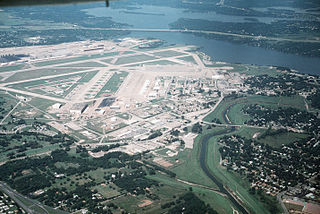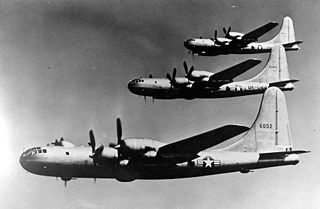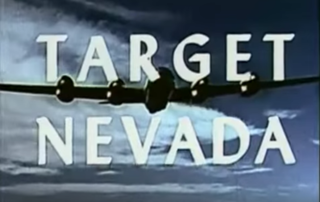
Strategic Air Command (SAC) was a United States Department of Defense Specified Command and a United States Air Force (USAF) Major Command responsible for command and control of the strategic bomber and intercontinental ballistic missile components of the United States military's strategic nuclear forces from 1946 to 1992. SAC was also responsible for the operation of strategic reconnaissance aircraft and airborne command post aircraft as well as most of the USAF's aerial refueling fleet, including aircraft from the Air Force Reserve (AFRES) and Air National Guard (ANG).

Eielson Air Force Base is a United States Air Force (USAF) base located approximately 26 miles (42 km) southeast of Fairbanks, Alaska, and just southeast of Moose Creek, Alaska. It was established in 1943 as Mile 26 Satellite Field and redesignated Eielson Air Force Base on 13 January 1948. It has been a Superfund site since 1989. Eielson AFB was named in honor of polar pilot Carl Ben Eielson.

The Boeing B-47 Stratojet is a retired American long-range, six-engined, turbojet-powered strategic bomber designed to fly at high subsonic speed and at high altitude to avoid enemy interceptor aircraft. The primary mission of the B-47 was as a nuclear bomber capable of striking targets within the Soviet Union.

The Convair B-36 "Peacemaker" is a retired strategic bomber that was built by Convair and operated by the United States Air Force (USAF) from 1949 to 1959. The B-36 is the largest mass-produced piston-engined aircraft ever built. It has the longest wingspan of any combat aircraft ever built, at 230 ft (70 m). The B-36 was the first bomber capable of delivering any of the nuclear weapons in the U.S. arsenal from an internal bomb bay without aircraft modifications. With a range of 10,000 mi (16,000 km) and a maximum payload of 87,200 lb (39,600 kg), the B-36 was capable of intercontinental flight without refuelling.

The Convair B-58 Hustler, designed and produced by American aircraft manufacturer Convair, was the first operational bomber capable of Mach 2 flight.

Kirtland Air Force Base is a United States Air Force base. It is located in the southeast quadrant of the Albuquerque, New Mexico, urban area, adjacent to the Albuquerque International Sunport. The base was named for the early Army aviator Col. Roy C. Kirtland. The military and the international airport share the same runways, making ABQ a joint civil-military airport.

The Tybee Island mid-air collision was an incident on February 5, 1958, in which the United States Air Force lost a 7,600-pound (3,400 kg) Mark 15 nuclear bomb in the waters off Tybee Island near Savannah, Georgia, United States. During a night practice exercise, an F-86 fighter plane collided with the B-47 bomber carrying the large weapon.

The development of the Convair B-36 strategic bomber began in 1941 with the XB-36, which was intended to meet the strategic needs of the US Army Air Forces, and later of the United States Air Force with its Strategic Air Command. In 1948, the B-36 become a mainstay of the American nuclear deterrent. It underwent a number of design changes before being withdrawn from service in 1959. It was also well suited to high altitude very long range reconnaissance missions, and several alterations were made with this mission profile in mind.

Naval Air Station Joint Reserve Base Fort Worth includes Carswell Field, a military airbase located 5 nautical miles west of the central business district of Fort Worth, in Tarrant County, Texas, United States. This military airfield is operated by the United States Navy Reserve. It is located in the cities of Fort Worth, Westworth Village, and White Settlement in the western part of the Fort Worth urban area.
Carswell Air Force Base is a former United States Air Force (USAF) base, located northwest of Fort Worth, Texas. For most of its operational lifetime, the base's mission was to train and support heavy strategic bombing groups and wings.
The United States Armed Forces uses a number of terms to define the magnitude and extent of nuclear and radiation accidents and incidents in order to reduce the time taken to report the type of incident, thus streamlining the radio communications in the wake of the event.

The 7th Bomb Wing is a United States Air Force unit assigned to the Global Strike Command Eighth Air Force. It is stationed at Dyess Air Force Base, Texas, where it is also the host unit.

The Boeing B-52 Stratofortress is an American long-range, subsonic, jet-powered strategic bomber. The B-52 was designed and built by Boeing, which has continued to provide support and upgrades. It has been operated by the United States Air Force (USAF) since the 1950s. The bomber can carry up to 70,000 pounds (32,000 kg) of weapons, and has a typical combat range of around 8,800 miles (14,200 km) without aerial refueling.

The 4925th Test Group is a discontinued United States Air Force unit. It was last assigned to the 4901st Support Wing (Atomic), at Kirtland Air Force Base, New Mexico, where it was discontinued on 31 August 1961. Known as "The Megaton Blasters", the 4925th was responsible for the development flight testing of all USAF nuclear weapon delivery systems including conducting live test drops from 1951 though 1956. Following 1956 the group focused on operational methods and equipment for delivering nuclear weapons. It was discontinued when Air Force Systems Command replaced Air Research and Development Command and components of its mission were distributed among other units.

The 1950 Rivière-du-Loup B-50 nuclear weapon loss incident refers to loss of a nuclear weapon near Rivière-du-Loup, Quebec, Canada, during the fall of 1950. The bomb was released due to engine troubles, and then was destroyed in a non-nuclear detonation before it hit the ground.

Target Nevada Special Film Project (S.F.P.) 281 (1951) is an instructional documentary short film produced by United States Air Force (USAF). The film documents the story of the USAF support to the United States Atomic Energy Commission for 1949–1951 continental atom bomb tests. In an era of postwar "atomic scare" films, Target Nevada is a straightforward documentary film on nuclear weapons testing.

Biggs Army Airfield is a United States Army military airbase located on the Fort Bliss military base in El Paso, Texas.

Royal Air Force Upper Heyford or more simply RAF Upper Heyford is a former Royal Air Force station located 5 miles (8 km) north-west of Bicester near the village of Upper Heyford, Oxfordshire, England. In the Second World War the airfield was used by RAF Bomber Command. During the Cold War, Upper Heyford was one of the former RAF bases chosen to house the United States Air Force Strategic Air Command (SAC) nuclear-capable bombers on 90-day TDY deployments until 1959, SAC Reflex Alert deployments from 1959 until 1965, from 1966 United States Air Forces in Europe (USAFE) tactical reconnaissance aircraft, and from 1970 General Dynamics F-111 Aardvark strike aircraft.















